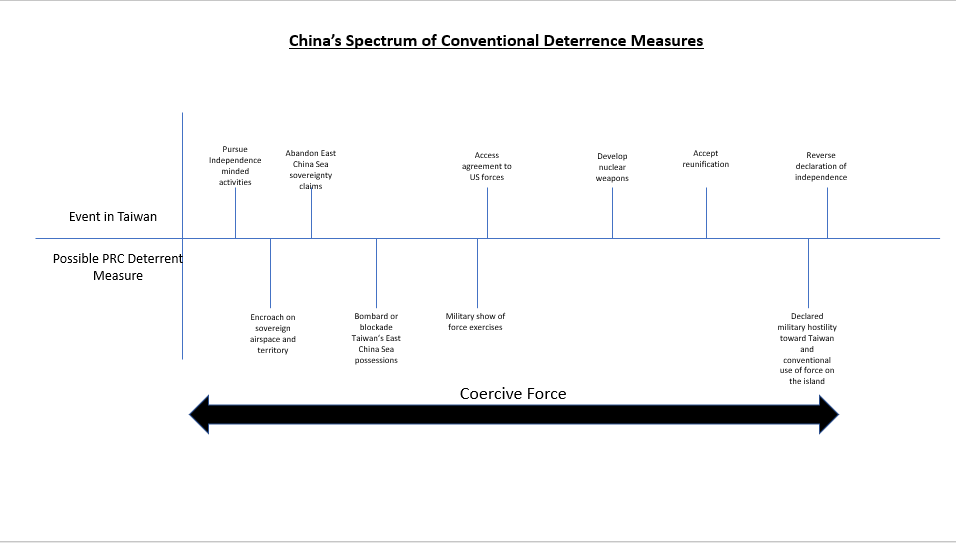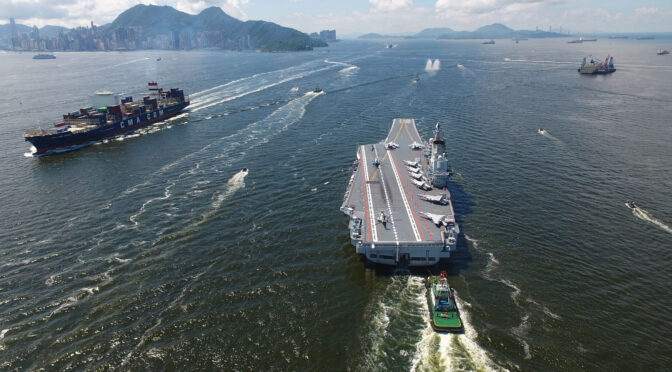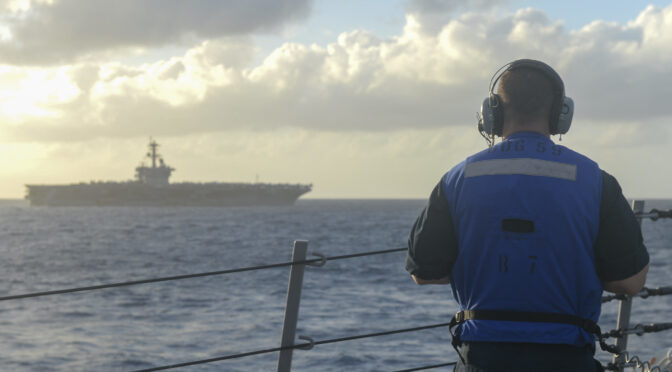Read Part One here.
By Adam Taylor
The challenges posed by China’s offensive deterrence paradigm require a new and innovative future force design for the US Navy. China’s deterrence model prizes confrontation and escalation in order to stop its neighbors from pursuing an unwelcome course of action, and, ultimately, force the target of its deterrent behavior to favor Beijing’s interests. This operating environment requires the US Navy to move from a fleet better suited for conventional war to an architecture that can succeed in a traditional great power conflict and countering Chinese deterrent behavior in the grey zone. A closer exploration of the US Navy’s response and involvement in deterring general war and Chinese aggression short of war in a Taiwan scenario demonstrates both the challenges confronting the current fleet and a possible force design roadmap the service can follow moving forward.
Any assessment of this question requires understanding Beijing’s interests in Taiwan and the range of behavior China might pursue to achieve its desired outcomes. In turn, this clarifies both the range of Chinese military behavior American forces must be prepared to deter and defend against, and whether current US force posture in the region meets those demands. Beijing’s most recent defense white paper makes clear that its overwhelming interest in Taiwan remains the islands reunification and incorporation into the PRC polity. China maintains numerous other interests in the island, however, and could employ a variety of deterrent stratagems to prevent Taiwan from pursuing various political ends at odds with Beijing’s preferences. Examples of China’s other interests could include deterring or reversing a “declaration of independence;” preventing Taiwan from developing nuclear weapons; compelling the abandonment of a military access agreement to US forces; deterring Taiwan’s electorate from pursuing an “independence-minded” course or influencing its electorate not to support candidates favoring such a course; compelling Taiwan to abandon sovereignty claims in the East China Sea (ECS); and forcing Taiwan to accept reunification.
Past examples of Chinese military action provide context for when the PRC will employ deterrent measures in response to developments within Taiwan and the form of force it will use.
Notable Security Events in Cross-Strait Relationship
| Historical Event | Year(s) | Circumstances | US Response | Notes |
| First Taiwan Strait Crisis | 1954 | PRC bombs Taiwan’s islands of Quemoy, Dachen, and Mazu. | The US signs mutual defense treaty with Taiwan. | Taiwan maintains Quemoy and Mazu islands. China gains Dachen island. |
| Second Taiwan Strait Crisis | 1958 | PRC bombs Quemoy and Mazu and establishes blockade around Quemoy to compel Taiwan to abandon claim to Quemoy. | US Navy escorts Taiwan’s resupply ships to Quemoy, breaking PRC blockade of island. US publicly commits to defense of Quemoy. | Taiwan renounces use of force to retake Chinese mainland. China frames crisis as an “internal affair,” and uses the conflict to exacerbate relations between US and Taiwan. |
| Third Taiwan Strait Crisis | 1995-1996 | PRC conducts show of force exercises and missile tests near Taiwan in response to US policy toward Taiwan and public support in Taiwan for pro-independence regime. | The US deploys two carrier battle groups to the Taiwan Strait. | The US publicly and explicitly states it does not support Taiwan’s independence. US’ conventional deterrent response assured throughout region. |
| ECS ADIZ Establishment | 2013 | China establishes ADIZ outside accepted international legal norms. ADIZ contests Japan and Taiwan’s sovereignty claims to same airspace and islands in ECS. | America labels ADIZ establishment as “unilateral change to the status quo.” | US continues flight operations through China’s ADIZ in ECS. |
| Island Encirclement Drills | 2016 | PRC begins regular PLAN and PLAAF exercises around Taiwan to “protect China’s sovereignty.” Exercises occur following election of pro-independence president, Tsai Ing-wen. | US officials condemn exercises. American forces support Taiwan defense force freedom of navigation operations. | Encirclement drills ongoing. |
Both the Second and Third Taiwan Strait Crises demonstrate that Beijing would resort to abnormal levels of conventional hostility and force to compel Taiwan to abandon its ECS territorial claims or to express its displeasure with political developments that threaten the prospective reunification of Taiwan with China. Beijing’s ADIZ establishment and encirclement drills illustrate that it also relies on related, albeit less pronounced, compellent measures to further its sovereignty claims over Taiwan. These security developments demonstrate the expanding depth of China’s conventional deterrent policy tool kit and the range of scenarios US forces must be equipped to deter.
The PRC’s growing military capabilities also complicate any response to Chinese belligerence towards Taiwan. China now possesses the largest navy in the world, and, per the most recent Department of Defense report on Chinese military power, maintains the largest number of aviation forces in the Asia-Pacific as well as a growing inventory of conventional missiles. While force size alone does not determine the military balance, these developments suggest Beijing now has access to a broader range of tools to advance its goals in the cross-strait relationship.
Given available knowledge about China’s deterrence practices and its forces’ composition and disposition, it becomes possible to create a spectrum of behavior that the joint force must be able to effectively deter in a Taiwan scenario. The figure below highlights this spectrum. The top half of the spectrum illustrates a range of events in Taiwan that the Chinese would utilize varying levels of force to deter. These events are extrapolated from understanding China’s general interests in Taiwan. Each event ranges from least to most threatening Beijing’s interests in Taiwan. The bottom half highlights possible compellent behavior China can pursue to deter events on the top half of the spectrum. The compellent force arrow demonstrates that left to right movement across the spectrum will lead to increasing levels of Chinese deterrent force against Taiwan. While there remains a correlation between Taiwan’s escalatory behavior and increasing Chinese deterrent force as one moves across the spectrum, this does not mean Beijing would not utilize lower levels of compellent force in response to an escalatory event along the spectrum. More important, however, the spectrum illustrates those scenarios when the Navy’s contributions to the joint force’s conventional deterrence posture would be tested. A closer look at the Navy’s ability to support operations aimed at stopping China from deterring Taiwan from policies that lead to de facto independence demonstrate the challenges confronting the service now and in the future.

China Deters Taiwan from Policies that Lead to de-facto Independence
The Third Taiwan Strait Crisis highlights Beijing’s use of military exercises and shows of force that target domestic developments within Taiwan or compel the US to change its policy towards the island. One can see similar circumstances unfold again should the people of Taiwan continue to elect pro-independence minded politicians or publicly support policies that Beijing might consider measures of de-facto independence, such as signing an access agreement for US forces or codifying policy that contradicts the “one China, two systems” policy. The spectrum of behavior suggests that China would resort to intense forms of hostility short of war. America would also likely pressure Taiwan’s leadership to stop such pronouncements for fear of conventional Chinese escalation. It may therefore seem misguided to only examine the utility of America’s current force composition and disposition to deter China’s use of military exercises, considering the seeming mismatch between the implications of outlined provocative domestic political behavior in Taiwan and the range of Chinese behavior. This question remains important, however, given the ability of China to use similar methods against other states in the region pursuing policies at odds with Beijing’s political goals.
In the last Taiwan Strait Crisis, America sailed two aircraft carriers through the strait to communicate America’s resolve to protect Taiwan. Would the threat of a similar response today meaningfully curtail Chinese military exercises or shows of force? Can the threat of sending US warships to signal resolve with Taiwan communicate to Beijing it should reconsider its course of action? Not anymore. Chinese forces today are both quantitatively and qualitatively superior to their forebears, and while they continue to be qualitatively inferior to their American counterparts, they now have the means to effectively engage US vessels. The declining capability gap found between American and Chinese platforms means the deterrent threat posed by current US forces has decreased. Furthermore, it remains a serious logistic, maintenance, and human endeavor to keep America’s highly capable ships at sea consistently and long enough. These conditions make America’s assortment of large platforms not always suited for the passive everyday presence necessary to reassure Taiwan and needed to communicate to the PRC the ability to impose costs should conflict arise.
This dilemma speaks to the issues confronting the composition of the current USN fleet. While aircraft carriers and other large surface combatants possess incredible capabilities and maintain deterrent utility, their size and relative paucity in number make them susceptible to a variety of China’s anti-access/area denial (A2/AD) threats and difficult to replace should conflict occur. In the words of one US naval professional, “our fleet is too small, and our capabilities are stacked on too few ships that are too big.” Beijing recognizes the operational problem this poses for US military leaders. In turn, this likely informs how China would view the presence of American aircraft carriers or other large platforms in the Taiwan Straits in response to a military show of force exercise. Chinese leaders may view the presence of such platforms as provocative and an important reminder of the force America can bring to bear in a general conflict, but not necessarily an incentive to stop its aggressive behavior. This represents an important consideration for leaders in Washington as they consider the many requests from allies and combatant commanders for the presence of carriers and America’s larger surface combatants in their respective territory or area of operations.
This scenario raises important questions about the utility of the Navy’s current fleet architecture and the service’s future force design goals. These issues led Department of Defense (DoD) leaders to commission a series of force design studies from the Office of Cost Assessment and Program Evaluation (CAPE), the Hudson Institute, and within the Office of the Secretary of Defense to inform their future force design proposal. Together, these studies influenced the Navy’s Battle Force 2045 future force design proposal. While details surrounding the CAPE study remain unavailable to the public, both the Hudson Institute and Battle Force 2045 proposals highlight the direction DoD will take the future fleet.
Unfortunately, Battle Force 2045 falls short of the service’s actual needs because it makes a series of unrealistic assumptions about DoD’s future financial resources and Congress. While this proposal has received much time and attention elsewhere, its shortcomings deserve brief consideration. Two notable issues include the costs associated with a 500-ship fleet and the politics associated with platform divestment decisions. Despite a historically high budget in fiscal year (FY)20, the navy’s current fleet of 300 ships accounts for roughly half its size in FY85. This suggests that maintaining the current force is increasingly expensive relative to previous years and will limit any increase in fleet size. Many legislators will also resist stopping procurement of existing platforms built in their districts and naval leadership would also need to engage in a parochial struggle over which platforms to cut. These and many other issues will limit the ability of the Navy, Congress, and defense enterprise from quickly achieving the consensus needed to build the future fleet the Navy needs.
A Better Fleet
Navy and DoD leaders can take important steps now, however, to ensure the service will succeed as a conventional deterrent in both the near and long term. Some of these steps include:
Reduce the advantage of China’s local balance of forces. China’s quantitative force advantage in the region means it will likely maintain and increase its ability to field a larger force in any future contingency within the first island chain. This balance of forces allows it to quickly mass its forces and complicate any US or combined response to conventional Chinese aggression. States who remain possible objects of Beijing’s aggression like Taiwan, the Philippines, or Vietnam will likely need to confront Chinese forces in response to malign conventional behavior short of war or in the initial stages of any deterrent action with limited US support. These states can mitigate the Beijing’s balance of forces advantage by increasing the deterrent utility of their security forces. America can support this goal by both increasing its arms sales to these nations and facilitating greater training opportunities designed to qualitatively improve partners’ capabilities. Although the China will likely view such a strategy as antagonistic, it provides a cost-effective way for the US to increase the deterrent capability of its partners.
Incorporate cheaper and more expendable platforms. America’s high end warfighting platforms do not always provide the best deterrent response options because they remain expensive to employ, costly to replace, and potentially vulnerable to the threats posed by China’s well developed A2/AD capabilities. Beijing can use these considerations to pursue courses of action that advance its interests while reducing the passive threat posed by US forces in the Asia-Pacific. America could respond to this dilemma by trying to increase the number of high-end ships in its fleet, but this approach remains unsustainable. Both the Congressional Budget Office and Congressional Research Service recently concluded that the cost of maintaining a 355-ship fleet (let alone 500 ships) over 30 years would exceed the cost of purchasing new ships. This crowding out effect could prove disastrous for future US defense planners who want to field new generations of technology across the feet or build newer ships. While the Biden administration’s recently released “skinny budget” and comments from the current Chairman of the Joint Chiefs of Staff suggest a future naval shipbuilding boon, it remains difficult to assess if this thinking maintains long-term political support if it leads to cuts from the other services’ toplines.
The Navy can mitigate this issue by divesting from legacy platforms today and reinvesting those savings into research and development projects that increase the capability of platforms currently in service and into cheaper and more expendable platforms. Although this modernization window may provide Beijing an opportunity to act, it would provide the service with the investment needed to ensure long-term success.
While these cheaper ships would likely not have the individual capability of other platforms found throughout the fleet, they could provide the means to place a limited suite of capabilities on highly survivable platforms. These platforms, in turn, would be able to operate in A2/AD environments within zones of contention for longer periods of time and would be more easily replaced. Such ships would provide a credible denial deterrence capability by reducing China’s quantitative balance of forces advantage and increasing the qualitative ability of the deterrent response from the US and its partners.
Reconsider offset strategies to bridge the gap between the present and future. The Third Offset Strategy first introduced under the Obama administration provides a possible near term solution that can meet this goal. This initiative prioritized investments in projects like laser weapons that could shoot down enemy missiles at a fraction of the cost of current missile defense systems; modifying traditional cannon to fire guided hyper velocity projectiles; and investment in increasing the range of the navy’s Tomahawk missiles or the payloads of its submarines by decreasing procurement of more ships. While this would sacrifice procurement and acquisition of some platforms in the near term, it could lead to savings the Department of Defense needs to invest in cutting-edge technologies. These investments would also mitigate vulnerabilities associated with any modernization window. Many of these technologies would increase the operational reach and efficacy of existing platforms, which, in turn, may increase the deterrent utility of the fleet in the near-term and better posture the service to field more deterrent and defense credible ships in the future.
Beijing’s competitive deterrence model has led it to fashion a force that targets the vulnerabilities found within the Navy’s existing fleet, which is why the Navy cannot afford to double down on a losing force design like Battle Force 2045. Instead, service leadership must be willing to make difficult decisions today that prioritize divestment from legacy platforms and investment into future platforms and technologies that ensure America can field qualitatively superior platforms at scale that are able to deter China across the spectrum of competition.
Adam Taylor recently separated from the Marine Corps where he served four years as an air support control officer and is now in the Individual Ready Reserve. He currently works as a fellow in Congress and received his M.A. in international relations from American University’s School of International Service. The opinions expressed here are his own and do not reflect any institutional position of the Marine Corps, Department of the Navy, Department of Defense, or Member of Congress.
Featured Image: China’s first aircraft carrier, the Liaoning, leaves after wrapping up a five-day visit to the Hong Kong Special Administrative Region (SAR), south China, July 11, 2017. A departure ceremony was held at the Ngong Shuen Chau Barracks of the People’s Liberation Army (PLA) Hong Kong Garrison by the HKSAR government. (Photo via Xinhua/Zeng Tao)





